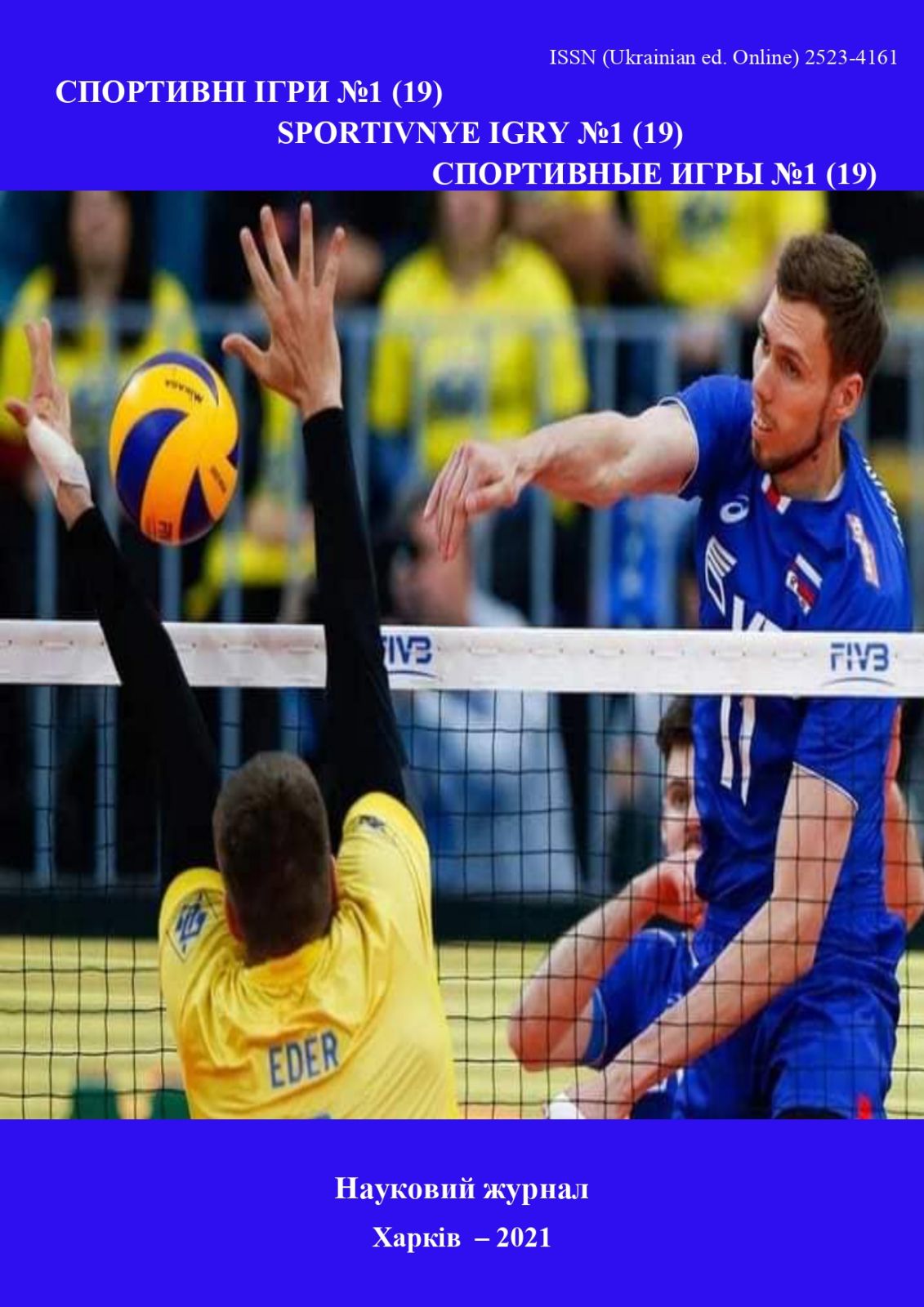Analysis of the teams’ competitive activity of the European Football Championship 2020
DOI:
https://doi.org/10.15391/si.2021-1.03Keywords:
analysis, competition, football, European championshipAbstract
Purpose: to analyze the
indicators of the teams’ competitive activity in the qualifying part of the European Football
Championship 2020. Materials and research methods. The following basic methods were used in
the work: analysis of scientific and methodological literature and Internet resources, analysis of
official competition protocols, methods of mathematical statistics; analysis, synthesis and modeling
of some aspects of the competitive activity of football teams. The competitive activity indicators of
the 20 teams that were selected for the European Football Championship 2020 were considered.
Matches were held from 21.03.2019 to 12.11.2020. A total of 250 matches were analyzed. The work
used indicators of the competitive activity of football teams, which are officially approved by
UEFA. Indicators of competitive activity: the number of shots, the number of shots on target, the
number of shots off target, the number of blocked shots, the number of corners, the number of
offsides, the percentage of possession, the number of passes, the number of accurate passes, the
number of yellow cards, the number of red cards, the number of fouls. Also considered indicators
such as the average number of goals scored and conceded. Results. According to the considered
indicators, the England national team became the most productive team in the qualification, on
average, the England score 4.6 goals per game. The Turkish national team conceded fewer goals
(0.2 goals per game). In terms of shots on target, Belgium is in the lead with an average of 9.2 shots
per game. The Spanish national team leads in terms of the total number of shots (22.0 hits per
game), blocked shots (6.4 strokes per game), the number of corners taken (10.0 corners per game),
in the accuracy of passes in the match (90.9 %) and the percentage of ball possession (70.4%). The
team that plays the roughest with opponents is the Hungarian national team. On average, they
receive 3.0 yellow cards per game. By the number of received red cards, the first place is shared by
2 teams. Slovakia and Hungary with an average of 0.3 respectively. Having analyzed the number of
fouls committed by the teams, the Czech national team is leading in this indicator with an average
result of 16.3 violations per match. Slovakia leads the way with 3.5 offside positions per game.
Conclusions. The indicators of the competitive activity of 20 teams that were selected for the
European Football Championship 2020 were analyzed. The profiles of the best teams of the 2018
World Cup show that the national teams demonstrate their own style of play, which brings results.
The profile of the Ukrainian national team demonstrates that our team looks like a balanced team
against the background of the C teams.
References
Дорошенко, Е.Ю., Цапенко, В.О., Шалфєєв, П.О., Петров, В.О., & Гусак, О.Ю. (2006). Параметри змагальної діяльності кваліфікованих футболістів (на прикладі ігор чемпіонату світу 2006 року). Педагогіка, психологія і медико-біологічні проблеми фізичного виховання та спорту, (12), 59-65.
Качалов, С.Б., Хромов, С.Е., & Антишин, А.В. (2019). Особенности соревновательной деятельности ведущих национальных сборных команд Европы по футболу. Ученые университета им. ПФ Лесгафта, (11 (177)), 160-164.
Костюкевич, В.М. (2016). Показатели технико-тактической деятельности футболистов высокой квали-фикации на чемпионате Европы 2016 года. Фізична культура, спорт та здоров’я нації, (1), 315-322.
Костюкевич, В. (2017). Тактические модели соревновательной деятельности в футболе. Наука в олимпийском спорте, (3), 40-50.
Коханець, П. (2017). Аналіз показників змагальної діяльності кваліфікованих футзалістів. Спортивний вісник Придніпров'я, (2), 87-90.
Латишев, М., Квасниця, О., Спесивих, О., & Квасниця, І. (2019). Прогнозування: методи, критерії та спортивний результат. Спортивний вісник Придніпров'я, (1), 39-47.
Лисенчук, Г., & Тищенко, В. (2020). Технология контроля технико-тактической подготовленности футболистов высокой квалификации. Наука в олимпийском спорте, (1), 52-56. doi:10.32652/olympic2020.1_4
Максименко, И.Г. (2009). Соревновательная и тренировочная деятельность футболистов: монография. Луганск: Знание, 258 с.
Перевозник, В.И., & Перцухов, А.А. (2017). Модельные показатели соревновательной деятельности футболистов высокой квалификации. Спортивні ігри, (1), 41-45.
Полищук Д., & Сушко Р. (2020). Вплив селекційної роботи у футболі на ефективність змагальної діяльності команд. Науковий часопис НПУ імені М. П. Драгоманова. Серія 15: Науково-педагогічні проблеми фізичної культури, 3(123), 113-119. doi10.31392/NPU-nc.series15.2020.3(123).22.
Соловей, О.М., & Соловей, Д.О. (2017). Змагальна діяльність футбольних клубів Європи в історичному аспекті розвитку виду спорту. Здоровье, спорт, реабилитация, (3), 39-44.
Стасюк, В. (2016). Порівняльний аналіз показників змагальної діяльності футболістів різної кваліфікації. Фізична культура, спорт та здоров’я нації, (2), 207-211.
Шамардин, В.Н. (2011). Характеристика особенностей атакующих действий футбольных команд высокой квалификации. Спортuвний вісник Придніпров’я, 1, 133–136.
Amatria, M., Maneiro-Dios, R., & Anguera, M.T. (2019). Analysis of the Success of the Spanish National Football Team in the UEFA Euro 2012. Apunts. Educació Física i Esports, (137), 85-102. doi:10.5672/apunts.2014-0983.cat.(2019/3).137.07
Memmert, D. (2019). Data Analytics in Football: Positional Data Collection, Modeling, and Analysis. Journal of Sport Management, 33, 574. doi.org/10.1123/jsm.2019-0308
Shafizadeh, M., Taylor, M., & Peñas, C.L. (2013). Performance consistency of international soccer teams in Euro 2012: A time series analysis. Journal of human kinetics, 38(1), 213-226.
Tokul, E., & Mülazimoglu, O. (2018). Analyzing the Process from the Initiation of Attack to Goal Scoring Touch in the EURO 2016. Universal Journal of Educational Research, 6(12), 2738-2742. doi: 10.13189/ujer.2018.061206UEFA EURO 2020 Retrieved from URL https://www.uefa.com/uefaeuro-2020/
Winter, C., & Pfeiffer, M. (2016). Tactical metrics that discriminate winning, drawing and losing teams in UEFA Euro 2012®. Journal of sports sciences, 34(6), 486-492.
doi.org/10.1080/02640414.2015.1099714













